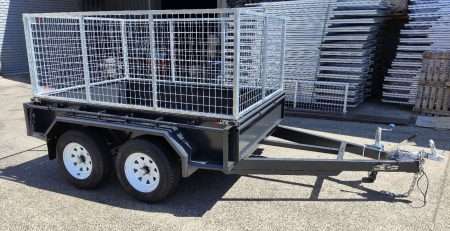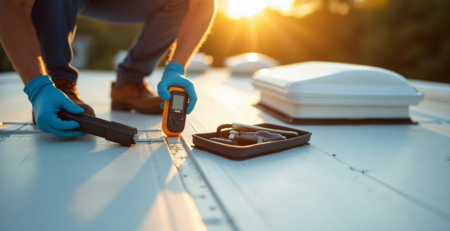
The Ultimate Guide to Selecting a High-Performance Trailer Light Kit
Understanding Trailer Light Kits
A trailer light kit is an essential component of any trailer setup. The kit typically includes tail lights, brake lights, turn signals, and licence plate lights, all of which play a crucial role in ensuring visibility and safety when towing a trailer.
Components of a Trailer Light Kit
The exact components of a trailer light kit can vary, but typically they include the following:
- Tail Lights: These are the main source of illumination from the back of the trailer, providing visibility to other vehicles on the road.
- Brake Lights: These lights illuminate when the vehicle’s brakes are applied, signalling to other drivers that the vehicle is slowing down or coming to a stop.
- Turn Signals: These lights indicate a change in direction, signalling to other drivers the intent to turn or change lanes.
- Licence Plate Lights: These lights illuminate the trailer’s licence plate, making it visible in low-light conditions.
The lights in a trailer light kit are connected to the vehicle’s electrical system, typically through a 4-way flat connector or a similar type of plug.
Types of Trailer Light Kits
There are several types of trailer light kits available, but the most common is a 4-way plug. This type of kit consists of four wires: green for right turn and brake, yellow for left turn and brake, brown for tail lights, and white for ground (instructables).
It’s important to choose a trailer light kit that is compatible with your vehicle and meets your towing needs. Factors to consider include the type of trailer, the towing capacity of the vehicle, and the specific lighting requirements for your region.
Understanding the components and types of trailer light kits is the first step in ensuring a safe and legal towing setup. For more information, check out our guides on trailer wiring harness, trailer hitch lock, and trailer brake controller.
Importance of Trailer Lights
The significance of a well-functioning trailer light kit goes beyond improving the aesthetics of your trailer. It’s a critical component for road safety and legal compliance.
Safety Concerns and Legal Requirements
Most states have laws requiring trailer light kits, which include necessary parts like tail lights, brake lights, turn signals, and license plate lights. These laws are designed to ensure visibility, signal intentions to other drivers, and maintain overall road safety.
The fact that having properly functioning trailer lights can result in fines or the inability to legally tow a trailer emphasizes the significance of a well-functioning trailer light kit. Therefore, it’s essential to ensure that all lights in the trailer light kit are functioning correctly before hitting the road.
Consequences of Malfunctioning Lights
Poorly functioning or non-functional trailer lights not only breach legal requirements but also pose a significant safety hazard on the road. Lack of proper lighting can lead to decreased visibility, especially in poor lighting conditions or adverse weather, increasing the risk of accidents. This is why proper installation and maintenance of trailer light kits are crucial to preventing accidents and complying with road safety requirements.
Malfunctioning lights can also result in fines from law enforcement, as they signify non-compliance with road safety regulations (Road Rescue).
In conclusion, the importance of fully operational trailer lights cannot be overstated. Whether you’re towing a trailer for work or leisure, the safety of you, your cargo, and other road users depends on it. As part of your pre-trip checks, always ensure your trailer light kit is in good working order. For guidance on other essential towing equipment, check out our articles on trailer brake controllers and trailer hitch locks.
Common Issues with Trailer Lights
When it comes to maintaining an effective trailer light kit, several issues can arise that may affect its performance. Understanding these common problems can help you troubleshoot issues more efficiently and enhance the longevity of your trailer lights. The two most common issues are grounding and electrical problems, and corrosion and damage to connectors.
Grounding and electrical problems
A common cause of trailer light problems is a faulty grounding connection. This can lead to erratic behaviour, dim lights, or lights that don’t work at all. Grounding issues usually stem from a poor connection between the trailer’s wiring system and the tow vehicle.
When troubleshooting grounding problems, it’s important to check the connection points and ensure they are clean, secure, and free of corrosion. Using a multimeter can be handy in confirming whether there’s continuity in your ground connection.
Additionally, the wiring harness should be properly secured and protected from damage to prevent associated issues. For more information on this, check out our guide on trailer wiring harnesses.
Another electrical issue that can affect the trailer lights is a blown fuse in the tow vehicle’s fuse box. If the trailer lights are not working, it’s crucial to check the fuses, as this could be the cause of the problem (Boating Magazine).
Corrosion and damage to connectors
Corrosion on the trailer light connectors can lead to poor electrical contact and cause the lights to malfunction. This often results from exposure to moisture and can be prevented through regular cleaning and maintenance.
One way to prevent corrosion and improve electrical contact is by applying dielectric grease to the connectors. This substance is a non-conductive, silicone-based grease that’s widely used in electrical applications to seal out moisture and prevent corrosion.
In addition to corrosion, physical damage to the connectors can also lead to issues with the trailer lights. Regular inspection and prompt repair or replacement of damaged connectors can help avoid these problems.
Understanding these common issues with trailer lights can help you maintain your trailer light kit effectively. Proper handling and timely resolution of these problems will ensure the efficiency of your trailer lights, enhancing your safety on the road.
Installing a Trailer Light Kit
The installation of a trailer light kit is an important process that ensures the correct functioning of the lights on a trailer. Proper installation and maintenance of these kits are crucial to preventing accidents and complying with road safety requirements. This section will guide you through the tools required and provide a step-by-step installation guide.
Tools required for installation
Before starting the installation process, it’s essential to gather all the necessary tools. Here is a list of the standard tools required for installing a trailer light kit:
- Wire Crimper
- Wire Cutter
- Screwdriver
- Electrical Tape
- Heat Gun (for heat-shrink connectors, if used)
Additionally, the specific trailer light kit might include other tools or hardware necessary for installation. Always refer to the manufacturer’s instructions to ensure you have everything you need before starting.
Step-by-Step Installation Guide
The installation process may vary depending on the specific trailer light kit, but the general steps are usually similar. Below is a simplified guide to installing a typical trailer light kit:
- Disconnect the trailer from the tow vehicle. This step is crucial for safety reasons. It prevents electrical issues or potential shocks during the installation process.
- Remove the Old Lights: If you’re replacing an existing trailer light kit, start by removing the old lights and wiring. Be careful not to damage the trailer’s body.
- Mount the New Lights: Follow the manufacturer’s instructions to mount the new lights correctly. Make sure they’re secure and correctly positioned.
- Run the New Wiring: Carefully run the new wiring from the lights to the front of the trailer. Ensure the wires are secure and won’t interfere with the operation of the trailer.
- Connect the Wires: Connect the wires according to the manufacturer’s instructions. This usually involves connecting colour-coded wires using wire crimpers.
- Test the lights: Before finalising the installation, connect the trailer to the tow vehicle and test the lights. Check all functions: tail lights, brake lights, turn signals, and licence plate lights.
Remember, each trailer light kit might have specific steps that need to be followed. Always refer to the specific instructions provided with your kit. For example, the installation of the Nilight LED trailer light kit is straightforward and is compatible with most trailers, including utility trailers, boat trailers, travel trailers, and more.
Properly installed lights are pivotal for the safety and legality of your trailer. If you encounter any issues during the installation process, consider seeking help from a professional. For more tips and guides related to towing products and accessories, explore other articles on hitch receivers, trailer wiring harnesses, and trailer brake controllers.
Maintaining your trailer lights
Maintaining the integrity of your trailer light kit goes a long way towards ensuring safety and compliance with legal road requirements. Regular inspection, cleaning, and preventive measures can keep your trailer lights in optimum condition.
Regular inspection and cleaning
Regular inspection of your trailer light kit can help identify potential issues such as loose connections, corroded wires, or damaged insulation. These issues can cause lights to malfunction or not work at all (Trailer Superstore).
During inspection, also check the fuses in the tow vehicle’s fuse box. A blown fuse could be the cause of non-functional trailer lights.
Cleaning is another essential maintenance activity. Corrosion on the trailer light connectors can lead to poor electrical contact and cause the lights to not function properly. Regular cleaning can prevent this issue.
Using dielectric grease on the trailer light connectors can help prevent corrosion and improve electrical contact.
Prevention of Wiring Damage
Maintaining the wiring of your trailer light kit involves ensuring that the trailer wiring harness is properly secured and protected from damage. This can prevent wiring issues that can affect the trailer lights (Boating Magazine).
If you are experiencing trailer light issues despite regular cleaning and inspection, it may be necessary to replace the entire kit. When choosing a new trailer light kit, consider reliable and high-quality options to ensure long-lasting and trouble-free operation of the trailer lights.
Maintaining your trailer lights is not just about ensuring their functionality. It’s also about safety and road legality. By regularly inspecting and cleaning your trailer light kit and taking measures to prevent wiring damage, you can ensure your trailer is ready for the road.
Troubleshooting Trailer Light Issues
Even with the best care, it is not uncommon to experience issues with your trailer light kit. This section will guide you through some simple ways to troubleshoot these issues.
Checking Fuses and Connections
If you’re experiencing issues with your trailer lights, the first step in troubleshooting should be to check the fuses and connections. As Trailer Superstore points out, a blown fuse or a loose connection can easily cause the lights to malfunction.
Start by checking the fuses in the tow vehicle’s fuse box. A blown fuse could be the cause of the problem and replacing it can often solve the issue. Next, inspect all electrical connections for signs of looseness or corrosion. Tightening loose connections and cleaning corroded ones can restore the functionality of the lights.
Grounding issues can also lead to trailer light problems. It can cause erratic behaviour, dim lights, or lights that don’t work at all. Checking the grounding connection and ensuring proper electrical contact is crucial for the lights to function properly (Trailer Superstore, Boating Magazine).
When to Replace the Light Kit
While troubleshooting can often solve common light issues, there may be times when a replacement of the entire trailer light kit is necessary. If the lights are not working even after checking the fuses and connections, it may be necessary to replace the kit.
When choosing a new kit, it’s important to select a reliable and high-quality product to ensure long-lasting and trouble-free operation of the trailer lights. This is a crucial part of maintaining the safety and legality of your trailer (Trailer Superstore).
Remember, even the best towing products, like trailer brake controllers and hitch receivers, rely on functioning lights for safe and legal operation. So, whether you’re using an electric winch or a trailer winch, always ensure your trailer light kit is in good working order.
Spotlight on a Top-Rated Product
To conclude our discussion on trailer light kits, let’s turn the spotlight on one of the best-selling products in this category: the Nilight LED trailer light kit. This kit has garnered much appreciation from users, boasting over 10,000 customer ratings and an impressive average rating of 4.7 out of 5 stars on Amazon.
Features of the Nilight LED Kit
The Nilight LED trailer light kit stands out due to its comprehensive features and superior quality. The kit includes two stop/turn/tail lights, two amber clearance lights, a 12V wiring harness with a 4-pin plug, and mounting hardware. This ensures that users have everything they need to set up a fully functional lighting system for their trailers.
Moreover, the Nilight LED trailer light kit is designed to be waterproof and durable, making it suitable for use in various weather conditions. This resilience contributes to the longevity of the product, providing users with a reliable lighting solution for their trailers.
Another notable feature of the Nilight LED trailer light kit is its compliance with Department of Transportation (DOT) standards. This guarantees that the product meets the safety and legal requirements for road use, providing users with peace of mind.
| Features of the Nilight LED Kit | Details |
|---|---|
| Stop/turn/tail lights | 2 |
| Amber clearance lights | 2 |
| Wiring harness | 12V with a 4-pin plug |
| Mounting hardware | Included |
| Waterproof | Yes |
| DOT compliant | Yes |
Installation and compatibility details
The installation of the Nilight LED trailer light kit is straightforward, making it easy for users to set the system up on their own. The kit includes all necessary mounting hardware, and the provided 12V wiring harness features a 4-pin plug for easy connection to the trailer’s electrical system.
In terms of compatibility, the Nilight LED trailer light kit is versatile and can be used with most trailers. This includes utility trailers, boat trailers, travel trailers, and more. This broad compatibility makes the Nilight LED kit a suitable choice for a variety of towing needs.
For further guidance on installation and to explore other towing products, visit our pages on trailer wiring harnesses and trailer hitch locks.
Author
I am Rahatul Ashiq Tamal. Another author of Muscle Trailers. Muscle Trailers is a well-known trailer brand in Sydney, Melbourne & Adelaide

How to Mount a Spare Tire on Your Trailer: A Simple Step-by-Step Guide
Trailer service centers receive over 1 million phone calls and 1.3 million emails each year about trailer maintenance problems....

How to Fix RV Roof Leaks: Simple Roof Leak Detection Guide for Beginners
Did you know DIY RV roof repairs can cost under $50? But undetected leaks could lead to substantially higher repair...

Starting a Food Truck Business in Australia: From Trailer Selection to Launch
The Australian mobile food market has evolved into a billion-dollar industry. This makes a food truck...
